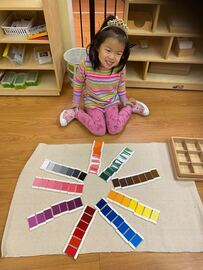Sensorial Area

From the birth of the child, until three years of age, every normal child will have numerous of impressions of the world stores in his brain. He has notions of softness, hardness, height, length, color, and other kind of sensorial experiences through unconscious absorbent mind. However, these impressions are stored without classification. Roughly starts from about three years old, children are going through a very particular moment towards the refinement of the senses. During this time, children are hypersensitive towards sensorial activities to further their knowledge of the world of senses and to categorize the impressions they stored previously.
Dr. Montessori states, “During these years a child develop his senses and his attention is directed towards the environment. During this period he should therefore be methodically exposed to stimuli that will develop his senses rationally and thus lay the foundation for his mental powers.”(The advanced Montessori Method Vol. 1) Based on her own observation, she confirmed that in order for a child to generate abstract ideas, he must first go through the concrete stage of exploration with the senses. To assist children going through this concrete stage with ease, she developed the sensorial area.
These materials promote prolong attentions towards the qualities possess in them are the fundamental base of this area. Children initiate their experiences with the activities and the directress solidifies their knowledge by introducing languages associate with particular qualities. The purpose of the sensorial activities is for the child to acquire clear, conscious information and to be able to make classifications in his environment.
The Sensorial Activities are divided into following
· Visual activities: color tablets, cylinder blocks (sizes), red rod (length), etc.
· Tactile activities: Rough and smooth boards (textures), Baric Tablets (weight), thermic bottle (temperature), etc.
· Auditory activities: music bells, sound cylinders
· Gustatory activities: tasting bottles
· Olfactory activities: smelling bottles
Dr. Montessori states, “During these years a child develop his senses and his attention is directed towards the environment. During this period he should therefore be methodically exposed to stimuli that will develop his senses rationally and thus lay the foundation for his mental powers.”(The advanced Montessori Method Vol. 1) Based on her own observation, she confirmed that in order for a child to generate abstract ideas, he must first go through the concrete stage of exploration with the senses. To assist children going through this concrete stage with ease, she developed the sensorial area.
These materials promote prolong attentions towards the qualities possess in them are the fundamental base of this area. Children initiate their experiences with the activities and the directress solidifies their knowledge by introducing languages associate with particular qualities. The purpose of the sensorial activities is for the child to acquire clear, conscious information and to be able to make classifications in his environment.
The Sensorial Activities are divided into following
· Visual activities: color tablets, cylinder blocks (sizes), red rod (length), etc.
· Tactile activities: Rough and smooth boards (textures), Baric Tablets (weight), thermic bottle (temperature), etc.
· Auditory activities: music bells, sound cylinders
· Gustatory activities: tasting bottles
· Olfactory activities: smelling bottles
